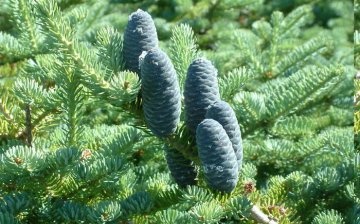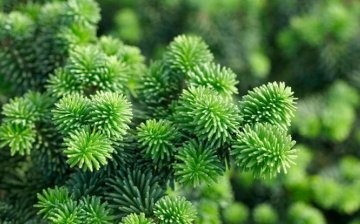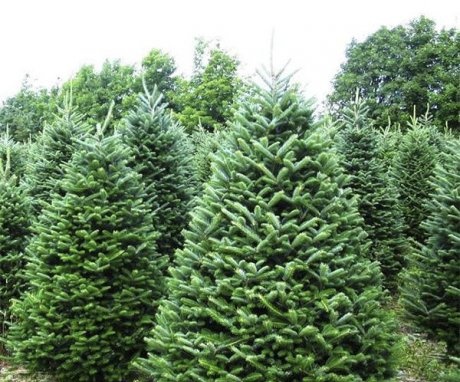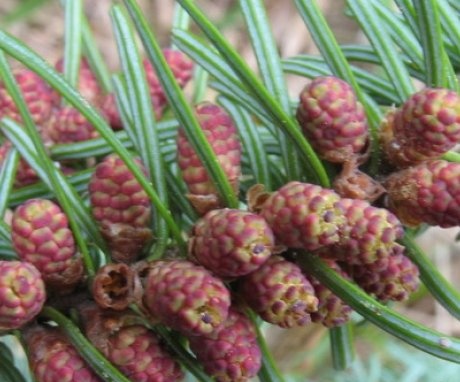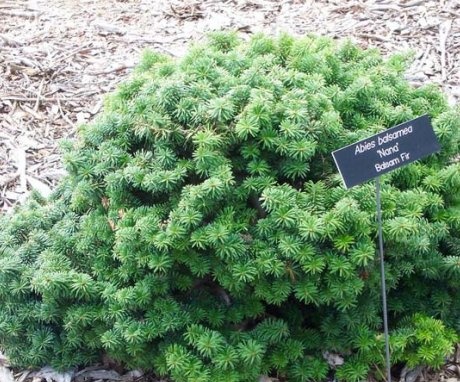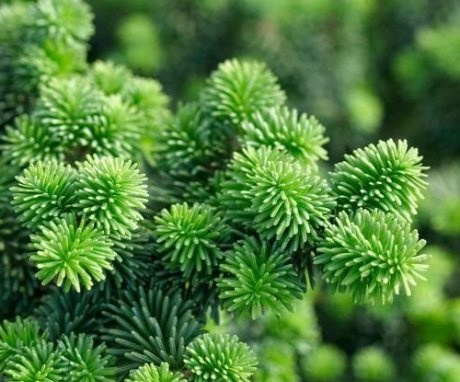Canadian fir: cultivation and use
Canadian fir is a plant of the genus Fir of the Pine family. It has another name - balsam fir (Abies balsamea). The tree is widespread in the mountainous regions of Canada and North America. It grows up to 200 years old. Grown as a garden plant from the end of the XVII century.
Content:
- Canadian fir: description and types
- Reproduction and planting
- Care, diseases and pests
- Use of Canadian fir
Canadian fir: description and types
The Canadian fir is an evergreen coniferous tree with a beautiful symmetrical crown. Most often it has the shape of a cone, but it can be narrowly pyramidal. The crown is dense, the branches of trees growing alone are lowered to the ground.
The bark of young trees is light gray, reddish-brown in adults. In trees over 100 years old, the bark cracks. In young firs, it is covered with a large number of gum nodules. In mature trees, they turn into cracks and canals. Resin moves along them and is released outward. There are many of them, which is why the tree is called balsamic. Fir differs from other types of conifers in that the resin passages are located not in the wood, but in the bark.
The needles are soft, flat, with rounded tips. Therefore, it is not prickly. In some varieties, the needles have a notch at the end. The length of the needles is 2-3.5 cm, the width is 2 mm. The color above is dark green, below - with a blue tint and two stripes on either side of the central vein. The needles are located on the branches in a spiral, perpendicular to the branch. Each needle lives for 4-7 years.
Young shoots are green, pubescent. Then they turn brown, the hairs disappear. The buds are spherical or ovoid, greenish-purple. If you touch them, you can feel a sticky resin. When rubbed, a pleasant smell of needles is felt.
Upon reaching 20-30 years, the fir blooms, forming cones.
They are divided into female and male. Male cones are located in the axils of the needles singly. Womens are arranged vertically. They are cylindrical in shape. Their length is 5-10 cm, width is up to 2.5 cm. Cones consist of a large number of scales, covering and seed. The latter serve as a wing for large angular seeds.
The color of young cones is dark purple, mature ones are brown, a large amount of resin is released from them. Dusting occurs in 1-4 years. The tree grows slowly for the first decade, then faster. Fir continues to increase in height until old age, growing in nature up to 20-25 m, and in cultivated plantings 7-15 m. At the same time, its frost resistance increases. The diameter reaches 70 cm.
The weak point of the Canadian fir is the superficial root system... This can cause strong gusts of wind to pull it out of the ground. Canadian fir has about 20 varieties. All of them differ in that they have short protruding needles, in which the "parting" is visible.
Types of Canadian fir:
- "Hudsonia" - a bush up to 50 cm high. The crown is wide and dense, has a large number of short shoots. The color of the needles on top is dark green, below with a blue tint.
- "Nana" is a round bush up to 2 m in diameter. The branches grow horizontally. The needles are flat. The main color is dark green, the middle and edge are yellowish. Used in tapeworms, rock gardens. Grown in containers, it is used for landscaping areas. Shade tolerates well.It grows slowly, therefore, decorative plantings created with its help retain their appearance for a long time without requiring pruning.
- "Piccolo" up to 40 cm high. The needles are dark green, the buds are brown. Prized for the contrast between new and old needles.
- Glauca - has bluish needles.
- Silver - the ends of the needles are white.
- Variegata - needles with yellow inclusions.
- Columnaris with a columnar crown.
- Prostrata ("prostrate") with branches growing horizontally.
- Kiwi is a dwarf variety with dense, radially growing branches. Needles with a blue tint.
The wild form of the Canadian fir is also grown.
Reproduction and planting
Fir is propagated seeds, apical cuttings or layering. Collect seeds from cones stratify their a month or more. Wet sand is taken for stratification. But you need to bring seeds from the cold into a warm room gradually, gradually increasing the temperature. Sow in autumn or winter.
The roots of perennial cuttings, cut from the tops of branches, appear after 9 months. This time they need to be kept in a moist substrate. It is easier to grow a young plant by layering. They appear after the branches of the fir bent to the ground.
Canadian fir grows poorly in places with low air dryness. Therefore, it is better to plant it in rainy weather. If this is not foreseen, then they do it on cloudy warm days.
When planting Canadian fir, take into account the places of natural growth of the species.
The tree thrives on moist fertile soils. In nature, it grows on rocks and near rivers, including swamps, where spruces and pines with long roots will not grow.
Landing rules:
- A pit is being prepared, the depth of which should be 60-80 cm. Of these, 30 cm will be occupied by drainage, the rest of the place will be taken by the root system.
- In areas with heavy soil, drainage is prepared. To do this, a layer of gravel 20 cm deep is laid on the bottom of the prepared pit. mineral fertilizerssprinkled on top with a thick layer sawdust.
- The soil for planting fir must be well fertilized. It is prepared by mixing leafy earth, clay, humus, sand and peat.
- The soil is poured onto the drainage, on which the seedling is installed. It is expected that the root collar does not go deeper into the hole. Sprinkle the roots with the prepared soil. Watering.
The distance between trees planted in alleys is up to 5 m, on loose soils - up to 3.5 m. It is allowed to leave 2.5 m between plants. It is better to plant trees at the age of 5-10 years. Canadian fir loves sunny places. But in the first 5 years he prefers partial shade. Therefore, it must be planted behind bushes of medium height. For some time they will cover the fir from the sun, then the tree will outgrow the bush and will receive a sufficient amount of light. The soil for planting Canadian fir is loamy or aluvial. Does not like sandy and podzolic.
Care, diseases and pests
How to properly care for a fir:
- Canadian fir needs watering. Under an adult tree, 2-3 times per season, you need to add 20 liters of water. This is especially important in dry weather. At the same time, spraying is carried out, which will increase the humidity of the air.
- The tree needs feeding. Another portion mineral fertilizers bring in 2 years after transplantation. The procedure is repeated periodically.
- The soil around the seedlings mulch humus or peat. The areas between the bushes are loosened at a distance of 30 cm from the trunk so as not to damage the root system.
- It is better to replant fir in spring in April, and in autumn in September. Pruning of Canadian fir is carried out only in the spring. Remove dried branches, correct the shape of the crown. Fir branches do not break off so as not to harm the tree.
- The first years after planting, Canadian fir must be protected from frost by covering it with spruce branches. Its frost resistance will increase every year.
Fir pests and methods of dealing with them:
- The Canadian fir is affected by the hermes aphids. The needles turn yellow and deplete. Aphids appear in the form of a white bloom. On examination, you can see females and aphids. You need to fight by spraying with insecticides.
- False shields settle on young whorls. A fungus settles on the traces of their vital activity, black spots appear. Fight by installing trapping belts or sprayed with insecticides.
- The spider mite enmeshes the needles with cobwebs. It turns brown and falls off. You need to fight by maintaining high humidity, spraying with infusion garlic, dandelion or acaricides.
- Fir and pine angled-winged moths eat needles. Females of fir moths lay eggs, from which black caterpillars emerge. Pine Utteroptera appear as green caterpillars with dark stripes and a red head. As a result of their activity, the tree may dry out. Apply biologics and insecticides. Young shoots are eaten by a fir leafworm. The body of a gray caterpillar is covered with hairy warts. They have 8 pairs of movable legs.
Diseases of Canadian fir:
- Brown shute is manifested by yellowing of the needles, gluing of needles and the formation of black fruiting bodies.
- Fusarium - browning and falling of needles. Damage to the bark and high humidity contribute to the disease. Root decay can result from damage. It is necessary to fight diseases by spraying with preparations containing copper. They improve drainage by driving plastic pipes with a length of 30 cm around the tree. They will drain excess moisture.
- The worst disease is rust cancer. It manifests itself as fusiform thickenings. If they form on branches, they need to be removed urgently. If the trunk is affected, then it cannot be cured.
Use of Canadian fir
In regions of constant growth, Canadian fir is used as a Christmas tree. This is facilitated by the beautiful dense needles and the neat shape of the crown. Often they are not cut, but grown on the territory near the house. Canadian fir is widely used to create landscape compositions, alleys. Used in single landings.
Canadian fir cleans the air well from various gases. But she herself suffers from this. It is undesirable to plant fir in places with a high level of industrial pollution.
All parts of the tree are used in medicine, and essential oils are made from resin.
In Canada, balsamic fir resin is used to produce Canadian balsam, which is used for bonding optical glasses and other operations with optics. Canadian fir resin was used by Native Americans to treat bronchitis, tuberculosis, colds, dysentery, heart disease, rheumatism, and headaches. It can restore strength and in extreme situations it can be eaten.
More information can be found in the video:







